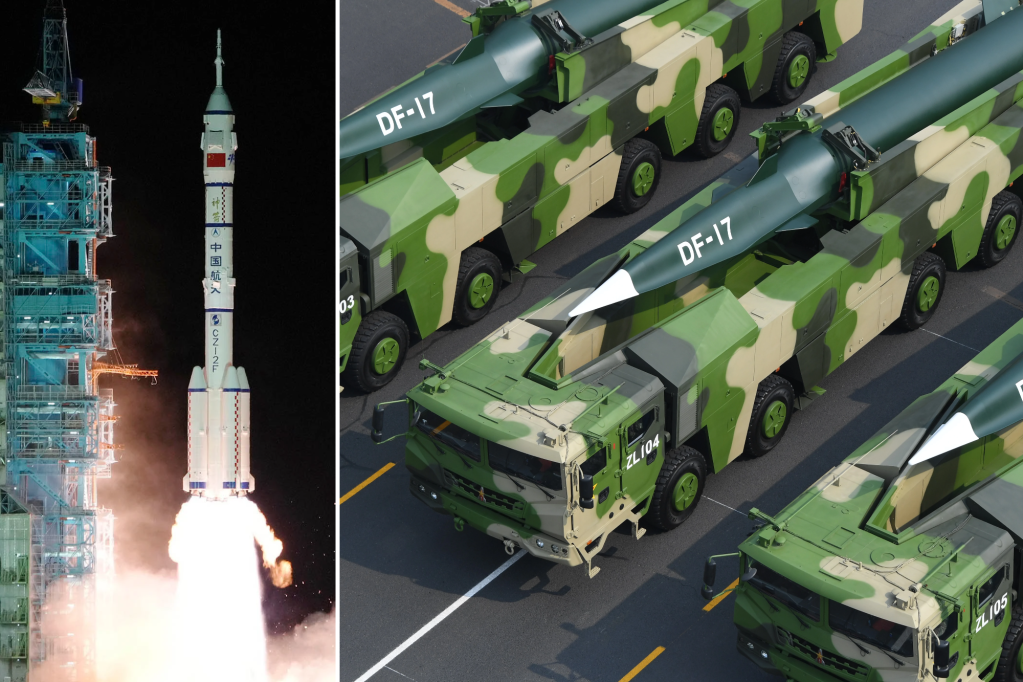The US Missile System Fueling Sino-American Tensions

Table of Contents
H2: The Evolution of US Missile Defense Capabilities
H3: From Cold War Legacy to Modern Systems: The history of US missile defense is intrinsically linked to the Cold War, initially focused on countering the Soviet Union's nuclear arsenal. Technological advancements have since led to a sophisticated network of systems designed to intercept ballistic and cruise missiles. This evolution has significantly influenced the current strategic competition with China.
- Examples of missile defense systems: The Terminal High Altitude Area Defense (THAAD) system, deployed in South Korea and elsewhere, is designed to intercept short and medium-range ballistic missiles in their terminal phase. The Aegis Ballistic Missile Defense (BMD) system, deployed on US Navy ships, utilizes sea-based interceptors. These systems represent significant technological advancements but also have inherent limitations.
- Deployment locations and capabilities: The geographic deployment of these systems, particularly in regions close to China, is a key factor in escalating tensions. While proponents argue these systems are purely defensive, their capabilities and location are viewed differently by China.
- Technological limitations and vulnerabilities: Current missile defense systems are not foolproof. They have limitations in intercepting hypersonic missiles and face challenges in dealing with saturation attacks – launching multiple missiles to overwhelm defenses.
H3: The Role of Missile Defense in US Strategy: Missile defense plays a pivotal role in US foreign and military policy within the Asia-Pacific region. It’s central to the US's commitment to defending allies like Japan and South Korea and deterring potential aggression from adversaries.
- Defending allies and deterring aggression: The US frames its missile defense deployments as crucial for protecting its allies and deterring attacks, particularly from North Korea and, implicitly, China.
- Maintaining regional stability: The US argues that a robust missile defense contributes to regional stability by dissuading potential aggressors. However, this argument is contested by China.
- Perceived threat from China's ballistic missile capabilities: China's rapid military modernization, including its development of increasingly sophisticated ballistic and hypersonic missiles, is seen by the US as a growing threat. This fuels the need for enhanced missile defense capabilities, further escalating tensions.
H2: China's Perspective and Response
H3: Perceived Threats and Security Concerns: China views the US missile defense system with considerable suspicion, viewing its deployment as a threat to its own national security and nuclear deterrence strategy.
- Concerns about US intentions: China questions the purely defensive nature of these systems, fearing they could be used offensively or to undermine China's nuclear deterrent.
- Potential for first-strike capability: Some analysts suggest that advanced missile defense systems could embolden the US to launch a first strike, knowing its own territory might be protected from retaliation. This fear exacerbates the strategic competition.
- Impact on its nuclear deterrence strategy: China’s nuclear arsenal is a key element of its national security strategy. The perceived ability of the US to intercept Chinese missiles threatens to undermine this deterrence, prompting a counter-response.
- China's military modernization: China's response includes its own efforts in developing advanced missile systems, including hypersonic weapons, creating a dangerous arms race and increasing geopolitical instability.
H3: Escalation and the Risk of Miscalculation: The interplay between the US missile system and China's response creates a high risk of miscalculation and accidental escalation, particularly regarding Taiwan and the South China Sea.
- Dangers of arms races: The ongoing arms race significantly increases the likelihood of conflict through misjudgment and miscalculation.
- Potential for misinterpretation of signals: Military exercises, deployments, and even unintentional incidents could be misinterpreted, leading to a rapid escalation of tensions.
- Role of communication and transparency: Open communication and transparency between the US and China are crucial to de-escalate tensions and prevent miscalculations. However, trust remains a significant obstacle.
H2: The Geopolitical Implications of the US Missile System
H3: Impact on Regional Stability: The US missile system significantly impacts regional stability in the Asia-Pacific.
- Responses of regional actors: Countries like Japan and South Korea, while allies of the US, also face complex considerations regarding their relationship with China. Their responses to the US missile system vary, adding further complexity to the geopolitical equation.
- Potential shifts in regional alliances: The perceived threat from China's military buildup, and the US response, could lead to shifts and strengthening of regional alliances, potentially creating new fault lines.
H3: Global Strategic Competition and the Arms Race: The Sino-American competition over missile defense has broader global implications.
- Costs of military spending: The massive investment in military technology diverts resources from critical areas like healthcare, education, and infrastructure, impacting global economic stability.
- Risk of a new Cold War: The escalating tensions mirror the dynamics of the Cold War, creating a climate of suspicion and mistrust that could lead to a new era of heightened global conflict.
3. Conclusion:
The US missile system is undeniably a key driver of Sino-American tensions. Its deployment, perceived capabilities, and strategic implications are deeply intertwined with the broader geopolitical landscape. The risk of miscalculation and accidental escalation is high, demanding careful consideration and proactive measures to de-escalate tensions. Understanding the complexities of this issue requires acknowledging both sides’ perspectives and engaging in informed discussions regarding the future development and deployment of missile defense systems. We need to prioritize diplomacy, transparency, and de-escalation strategies to prevent a disastrous conflict. To learn more about the ongoing dynamics of the US missile system and its impact on Sino-American relations, explore resources from reputable think tanks and academic institutions. The future of peace and stability hinges on addressing this critical issue effectively. The US missile system and its implications for global security require our continued attention and informed engagement.

Featured Posts
-
 Hypnotic To Atrocious A Critical Ranking Of Eurovision 2025 Finalists
May 20, 2025
Hypnotic To Atrocious A Critical Ranking Of Eurovision 2025 Finalists
May 20, 2025 -
 Cultivating Resilience Overcoming Challenges And Building Strength
May 20, 2025
Cultivating Resilience Overcoming Challenges And Building Strength
May 20, 2025 -
 Analyzing The Gop Tax Plan The Reality Of Deficit Reduction
May 20, 2025
Analyzing The Gop Tax Plan The Reality Of Deficit Reduction
May 20, 2025 -
 Biarritz Celebre Le 8 Mars Parcours De Femmes
May 20, 2025
Biarritz Celebre Le 8 Mars Parcours De Femmes
May 20, 2025 -
 Huuhkajat Mm Karsinnoissa Uusi Valmennus Ja Tavoitteet
May 20, 2025
Huuhkajat Mm Karsinnoissa Uusi Valmennus Ja Tavoitteet
May 20, 2025
